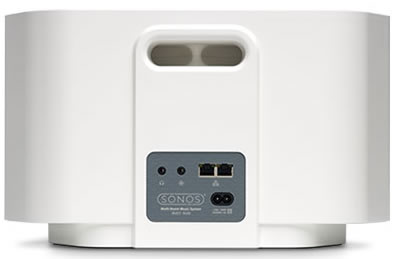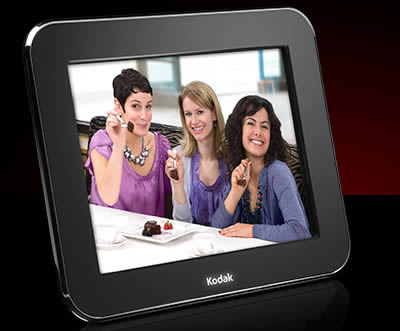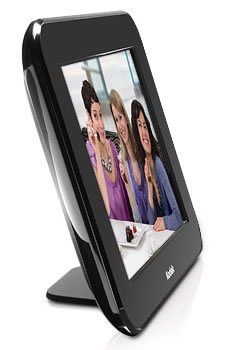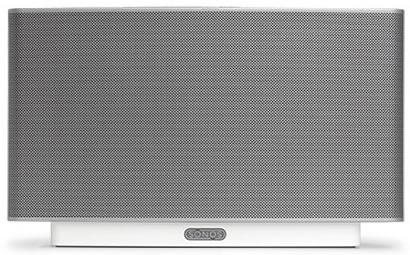|
|
||||
It works very well, too, with an easy setup routine. The device lets you access content from your network and the Internet, so you can find all kinds of interesting, rewarding and, as with most things, mostly banal things to see. It plugs directly into your router (and a wall outlet!) and once you've installed the software on your computer, you're off to the races.
The Sonos can also work in concert, no pun intended, with other S5's so you can build a mostly wireless multiroom system for your home.
The reason I say "mostly wirelessly" is because, while the units themselves work wirelessly, there needs to be a wired connection to your router for the first unit – or the optional ZoneBridge – before the rest will work wirelessly. And isn't that just weird?
Maybe I don't understand networks as much as I should, but needing to have a wired connection for a wireless device seems just strange, and isn't much use if your house isn't full of network cable already or you're unwilling to run such cable all through your house after the fact so you can use the Sonos.
I mean, in my home, the router is in the basement workshop, and I never spend any time there, so why would I want to have the base Sonos there? A better solution would have been to have Wi-Fi capability built right into the units instead of the kind of halfway solution Sonos has adopted, in which you have to shell out extra for a "ZoneBridge" unit to play go-between with the router.
Perhaps the proprietary nature is because of SonosNet 2.0, their wireless mesh network technology which they claim gives better range for whole-house wireless coverage and "ensures synchronous music playback, and avoids sources of wireless interference."
So maybe you should be grateful for buying the ZoneBridge, see?
Anyway, Sonos' five driver speaker system uses five dedicated Class D amplifiers and includes a pair of tweeters, two mid-range drivers and a subwoofer. There are buttons on the top for muting and for raising or lowering the volume; I could also control the volume with my iPhone.
 The volume's pretty good, too. I could have really annoyed my neighbors by cranking the unit up outside if I'd wanted to, but they're all bigger than me. Inside, it filled every room in which I tried it very well, with more than adequate volume for a little white (or black, if you prefer) box disconnected from any kind of larger audio system.
The volume's pretty good, too. I could have really annoyed my neighbors by cranking the unit up outside if I'd wanted to, but they're all bigger than me. Inside, it filled every room in which I tried it very well, with more than adequate volume for a little white (or black, if you prefer) box disconnected from any kind of larger audio system.
My benchmark for units like this is the Bose SoundDock 10, which doesn't work wirelessly unless you get a Bluetooth adapter but which does offer iPod/iPhone connectivity. If you sit them side by side, which I did, the Bose sounds better than the Sonos, with a more dynamic, clean and full sound but the Bose also sells for a couple of hundred clams more than the Sonos – and doesn't quite have the Sonos' flexibility.
Not that the Sonos is a shrill harpie ; it sounds fine, all things considered. I just wouldn't want it for my home theater.
The S5 has a handle built into its rear panel, as well as auxiliary, network and power connections. It feels substantial, but not such that you'll be tempted to never move it, which will encourage you to take it outside or from room to room. All you need in the new location is a power outlet.
The company says you can use the unit's auxiliary input to play tunes from iPod or CD player and listen to them on all the ZonePlayers in the house. I like the sound of that, no pun intended, though I only had one test unit and so couldn't try it.
Sonos says it offers free automatic software updates to ensure customers have access to the newest features and music services. It's an automatic notification that's set off when you register your system; subsequent system updates happen at the press of a button.
Framing the Discussion…
 Another neat wireless device is Kodak's PULSE digital frame. I've been playing with a 7 inch version of this Wi-Fi enabled (without needing a separate box!) frame, which lets you send pictures to it from faraway places if it's connected to the right technology.
Another neat wireless device is Kodak's PULSE digital frame. I've been playing with a 7 inch version of this Wi-Fi enabled (without needing a separate box!) frame, which lets you send pictures to it from faraway places if it's connected to the right technology.
What a great idea! When I got the press release I thought of my father immediately (no, his name isn't "immediately") and jumped to a wrong conclusion about how I could use such a frame to keep his picture collection fresh.
You see, my Dad doesn't have internet and I doubt he will. He doesn't need it and doesn't want it and even though it drives me crazy when I'm there and can't access my email, it's his right.
He also has a digital photo frame, but if we aren't there, the pictures never change. Wouldn't it be neat if I could update his picture frame from my home thousands of miles away? That's what I was hoping for from this Kodak.
An internet-enabled printer called Presto lets you send email to a remote printer, via a "digital to analog conversion service" which then uses a phone line to deliver the emails, much like you'd receive a fax, I assume. Sounds like a great way to forward him those jokes I get all the time via email. I'm sure there are a million serious uses, too. But that service isn't available where I live, so the point is moot.
Kodak's PULSE Digital Frame, on the other hand, has its own email address and you can send photos right to it from anywhere.
I can see the digital signage possibilities already!
The screen's pretty easy to use, with minimal buttons yet a reasonable selection of features accessible via touch screen. Setting up the network was easy once they'd erased the droid's memory of a previous reviewer. The networking is also nice because you can show pictures stored on your home network, giving you vastly more storage space that what's in the frame.
 And, for people still stuck in the technological dark ages of USB and SD cards, there are slots for just such emergencies as when you need physical media. You can also receive pictures from Facebook and KODAK Gallery albums and there are two slots for Secure Digital (SD), Secure Digital High Capacity (SDHC), Multimedia Card (MMC), Memory Stick (MS), MS PRO/MS PRO DUO, and XD-Picture Card (xD) media.
And, for people still stuck in the technological dark ages of USB and SD cards, there are slots for just such emergencies as when you need physical media. You can also receive pictures from Facebook and KODAK Gallery albums and there are two slots for Secure Digital (SD), Secure Digital High Capacity (SDHC), Multimedia Card (MMC), Memory Stick (MS), MS PRO/MS PRO DUO, and XD-Picture Card (xD) media.
Still reading? Okay. Internal memory is 512 MB.
The screen is LED-backlit and offers a resolution of 800 x 600, which won't set the world on fire but which looks fine in a seven inch screen. The aspect ratio, unfortunately, is 4:3 instead of the more desirable 16:9, but either way you'll be dealing with black bars on some of your shots. Picture quality is fine overall; my photos looked good (though others' weren't so fortunate!).
Alas, since the $130 frame uses the Internet to get its updates, it won't work at my Dad's house, so back to the drawing board there. But if you do have a live location, this is a pretty neat product and will do the job I wanted it to. If so, I'm jealous of you.
The only real complaint I can think of is that the PULSE is only available as a seven inch model. Hopefully Kodak will see fit to, er, expand the model line to larger frames.
Copyright 2010 Jim Bray
TechnoFile.com
Jim Bray's columns are available through the TechnoFile Syndicate.
 Networked Devices Spread Your Photos, Music Around
Networked Devices Spread Your Photos, Music Around